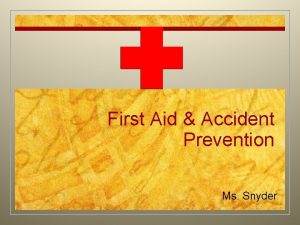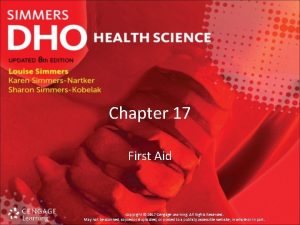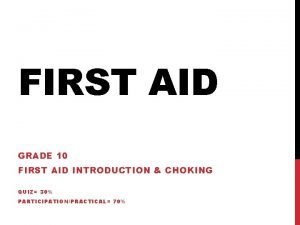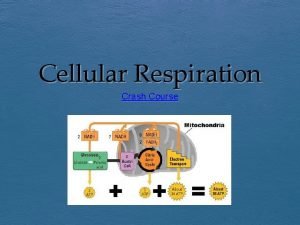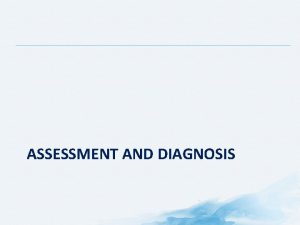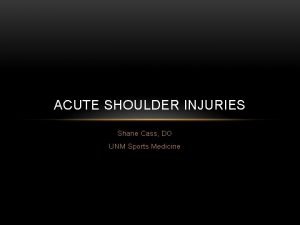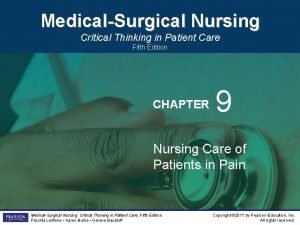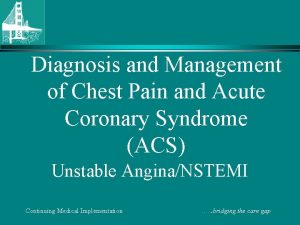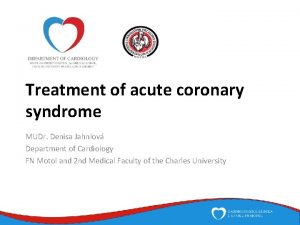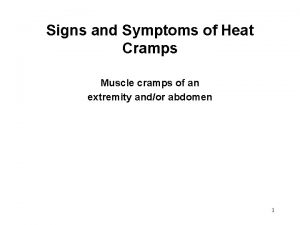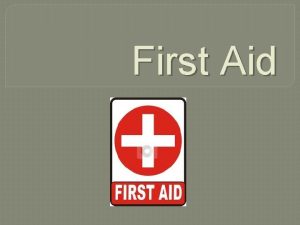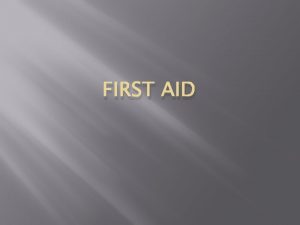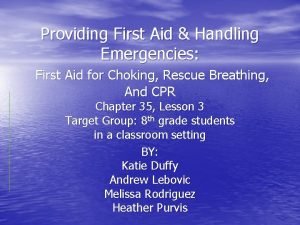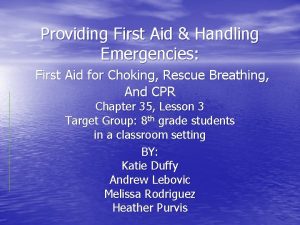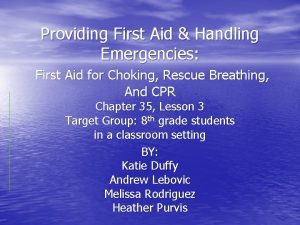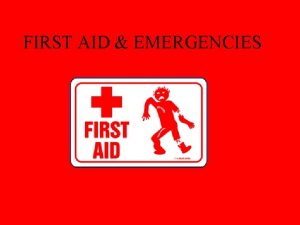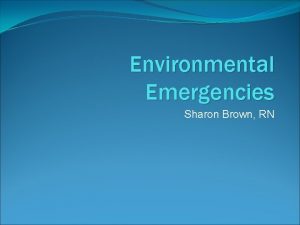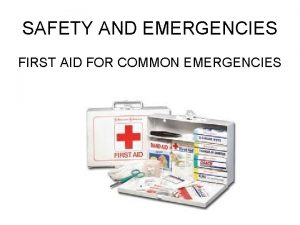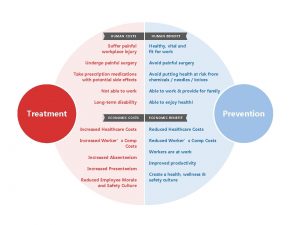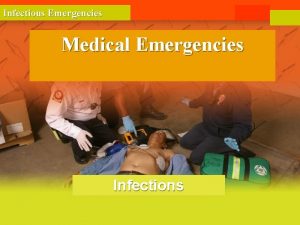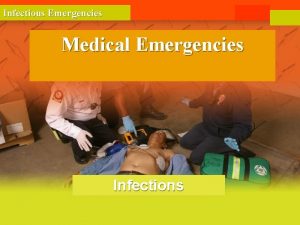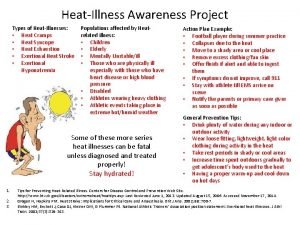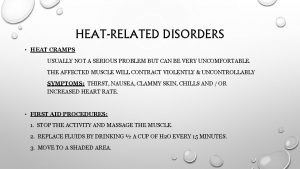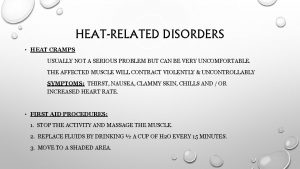First Aid Heat Related Emergencies Heat Cramps painful




















- Slides: 20

First Aid

Heat Related Emergencies Heat Cramps- painful muscle spasms, usually in legs or abdomen. They are least severe and usually a sign that the body is having trouble with the heat. � Move the person to cool place � Give them a sport type drink or water � Lightly stretch cramping muscle

Heat Exhaustion- More severe than heat cramps and include, cool moist skin, headache, nausea, dizziness, weakness and exhaustion � Move to cooler place � Apply cool wet clothes, spray person with water � Fan the person � Give small amounts of sports drink or water � If person gets worse call 9 -1 -1 �

� � � � � Heat Stroke- Least common and most severe. Develops when the bodies systems become overwhelmed by heat and stop functioning. Symptoms include Extremely high body temperature Red skin that can either be dry or moist Changes in consciousness Vomiting Rapid weak pulse Confusion Seizures

Care for Heat Stroke Call 9 -1 -1 � Rapidly cool the body temperature by immersing the person to the neck in cold water if possible or spray person with water � Sponge the person over the entire body with ice water doused towels � Cover the person with bags of ice � Care for other conditions found � Give fluids as tolerated depending on condition �

Cold Related Emergencies � Hypothermia � The lowering of the body’s core temperature to a point at which body function becomes impaired. Signs may include : shivering numbness glassy stare loss of consciousness � Care Call 9 -1 -1 Move to warm area Remove wet clothing and dry person � Warm body gradually by wrapping in blankets � Keep head covered to retain body heat � If they are alert give them warm fluids that do not contain caffeine or alcohol � � �

Frostbite � � � Freezing of a body part that has been exposed to the cold. Signs: Numbness or lack of feeling in affected area Skin that appears waxy, is cold to touch or discolored (black, white, yellow, blue) Blisters

Care for Frostbite Do not rub infected area which can cause tissue damage � For minor frostbite, rapidly re-warm the affected part by using skin to skin contact such as a warm hand. For more serious injury, gently soak the affected area in warm water � Keep frostbitten part in warm water until normal color returns � Loosely bandage the area with dry sterile bandage � Do not break blisters � If it is severe call 9 -1 -1 �

Soft Tissue Injuries � Wounds are usually classified as open or closed. In a closed wound the soft tissue damage occurs beneath the skin. The least severe is a bruise, also called a contusion. � 4 types of open wounds � Abrasions- scrapes � Lacerations- cuts � Avulsions or amputations � Punctures

Care for Open Wound � Put on Gloves! � Cover wound with dressing and firmly press against the wound until bleeding stops � Apply pressure bandage over the dressing to maintain pressure on the wound and to hold dressing in place. If the blood soaks through do not remove just add another bandage and continue to apply pressure.

General Care for Muscle, Bone or Joint Injury �RICE �Rest �Immobilize �Cold �Elevate

Nosebleeds � Sit with head slightly forward while pinching the nostrils together for 10 minutes. If pinching does not stop the bleeding: � Apply an ice pack to the bridge of the nose � Put pressure on the upper lip beneath the nose

Burns are classified by depth. The deeper the burn the more serious it is. Burns are also classified by sources: Thermal- from heat Chemical and Electrical Radiation- usually from the sun

What to do until help arrives: Thermal Burns/ Radiation Burns � Stop the burning by removing the person from the source of the burn. � Check for life threatening conditions � As soon as possible cool the burn with large amounts of cool water. � Cover the burn with loose sterile dressing � Do not remove pieces of cothing stuck to the burn.

Electrical Burns � Call 9 -1 -1� Be aware that electrocution cause cardiac and respiratory emergencies- be prepared to perform CPR or use an AED. � Look for entry and exit wounds and give appropriate care.

When is a burn considered critical? � Trouble breathing � If it covers more than 1 body part or a large surface area � Suspected burns to the airway � Burns to head, neck, feet or genitals � Has a burn resulting from chemicals, explosions or electricity

Diabetes � Diabetics may experience life-threatening emergencies from too much or too little insulin in their bodies. Too much insulin cause a low sugar level (hypoglycemia), which can lead to insulin shock. Not enough insulin cause a high level of sugar (hyperglycemia), which can cause a diabetic coma.

Diabetic Emergencies Symptoms of insulin shock include: � Weakness, drowsiness � Rapid pulse � Fast breathing � Pale, sweaty skin � Headache, trembling � Odorless breath � Numbness in hands or feet � Hunger Symptoms of diabetic coma include: � Weak and rapid pulse � Nausea � Deep, sighing breaths � Unsteady gait � Confusion � Flushed, warm, dry skin � Odor of nail polish or sweet apple � Drowsiness, gradual loss of consciousness

First aid for both conditions is the same: If the person is unconscious or unresponsive, call 911 or your local emergency number immediately. � If an unconscious person exhibits life-threatening conditions, place the person horizontally on a flat surface, check breathing, pulse and circulation, and administer CPR while waiting for professional medical assistance � If the person is conscious, alert and can assess the situation, assist him or her with getting sugar or necessary prescription medication. � If the person appears confused or disoriented, give him or her something to eat or drink and seek immediate medical assistance. �

Stroke Recognition Stroke- When the blood flow to part of the brain is cut off or when there is bleeding in the brain. FAST � Face-weakness or numbness � Arm-weakness or numbness in 1 arm � Speech-slurred speech or difficulty talking � Time-Try to determine when signals began- time is critical
 Symptoms of pregnancy during periods
Symptoms of pregnancy during periods Period vs pregnancy
Period vs pregnancy Chapter 28 lesson 1
Chapter 28 lesson 1 First aid merit badge first aid kit
First aid merit badge first aid kit Unit 15:8 providing first aid for cold exposure
Unit 15:8 providing first aid for cold exposure First aid for heat stroke
First aid for heat stroke 17:8 providing first aid for cold exposure
17:8 providing first aid for cold exposure 17:10 providing first aid for specific injuries
17:10 providing first aid for specific injuries Objective of first aid
Objective of first aid Cellular respiration crash course
Cellular respiration crash course Subacromial bursitis
Subacromial bursitis Dr.dilshan munidasa
Dr.dilshan munidasa What lessons did the skunk teach brian
What lessons did the skunk teach brian Description of pain
Description of pain Axillary view shoulder dislocation
Axillary view shoulder dislocation Classical conditioning vs operant
Classical conditioning vs operant Painful diminution of vision
Painful diminution of vision Kinesio tape for supraspinatus impingement
Kinesio tape for supraspinatus impingement Where is kidney pain felt diagram
Where is kidney pain felt diagram Painful lbbb
Painful lbbb Painful lbbb
Painful lbbb





